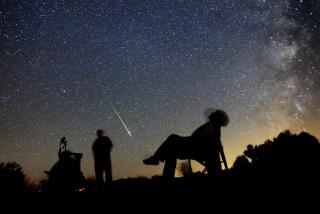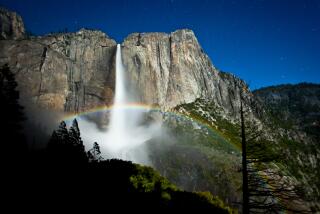How to, where to photograph a starry night sky

More than 4,000 stills were used in making this time-lapse video by Jack Fusco, courtesy Tourism Alberta.
- Share via
If the heavens fascinate you (and maybe Santa brought you a new camera), you may wonder how to take a photo that captures starlight like the ones used in the time-lapse video above.
That “how-to” question was on my mind in the fall as I headed to Jasper, Canada, home of the annual October Dark Sky Festival. (Jasper National Park is an official dark sky preserve.)
There I encountered Dark Sky photographer Jack Fusco, long a fan of Alberta and creator of the video above, “Chasing Starlight - An Adventure in the Canadian Rockies.”
“Jasper was always a place I wanted to visit since I saw my first photo [of it],” Fusco said in an interview about last year’s YouTube video for Travel Alberta. “The first time I saw Moraine Lake, it was amazing -- blue lakes, gorgeous mountains in the background.” Photographing it seemed “kind of like cheating because it’s just so beautiful.”
Fusco shared tips with me to help me in my quest to capture starlight:
--Get away from city lights. “Many places suffer from light pollution so getting to a dark sky is more important than anything else,” he said. “Alberta is at the top of my list of places to shoot the stars. It’s free of light pollution, has beautiful landscapes and Jasper and Banff are surrounded by the Canadian Rockies that block out light pollution.”
--Pay attention to the moon phase. During a new moon, stars are at their darkest, and can be challenging even with a headlamp. Try the first or last quarter phases of the moon where some moonlight can light up a landscape and help you practice.
--Dress appropriately, so you can stay out as long as possible and enjoy it. Alberta’s night temperatures can dip 40 degrees below zero. Long underwear is a must.
--Have a plan for the time and place you’ll shoot based on research. Fusco’s favorite resources include: Universe Today for knowing which planets may be most visible, Clear Dark Sky for its Light Pollution Map and Earthsky. “They have a great ‘Tonight’s Sky’ section and post a lot of informative articles,” Fusco said.
--Be flexible and prepared. Scouting locations during the day will save time and keep you safe from conditions that are unsuitable at night.
Follow us on Twitter at @latimestravel
More to Read
Sign up for The Wild
We’ll help you find the best places to hike, bike and run, as well as the perfect silent spots for meditation and yoga.
You may occasionally receive promotional content from the Los Angeles Times.






